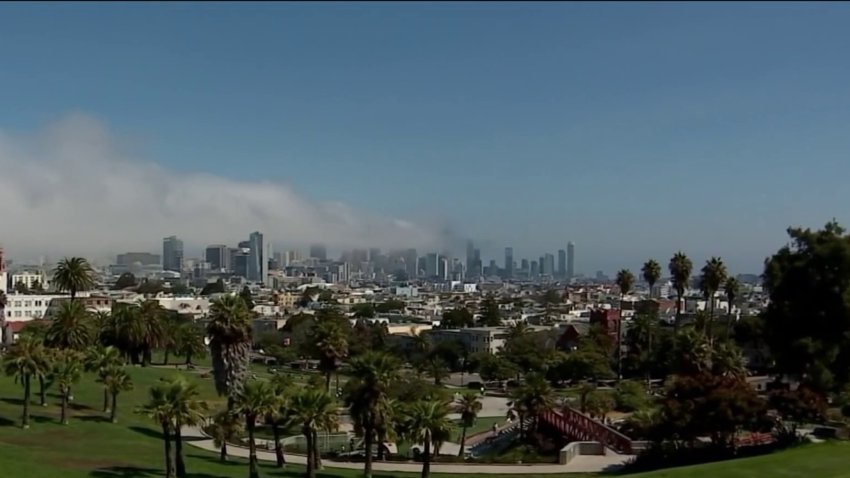A new project is getting underway in San Francisco. The goal is to track the heat to see how it affects different neighborhoods around the city. Christie Smith reports.
More than 30 volunteers participated in a community heat mapping project in San Francisco Friday called Urban Heat Watch as part of the city's efforts to address health inequities related to extreme heat.
Perfect timing, since San Francisco, along with the rest of the Bay Area, will be enduring an intense heat wave this Labor Day weekend.
While city agencies with roles in heat emergency response prepare to respond to elevated temperatures, city leaders are advising San Francisco residents to follow public health and safety guidance to stay safe and healthy during the heat.
"I want to thank the NOAA and all of the volunteers today for partnering with our public health and safety departments on furthering our commitment to address the impacts of climate change," Mayor London Breed said Friday. "That includes mitigating the impacts of rising temperature on our communities with equity as our guiding principle. In past years, our City workers have stood ready and came together to utilize our public spaces like libraries and museums and staffed cooling centers where residents in need of access to them could have safe places during times of extreme heat. As we continue our part in working on environmental issues that affect our everyday lives, this partnership with the NOAA will help strengthen our work serving all of our communities and addressing the long-term and short-term impacts brought on by climate change."
The city's Urban Heat Watch initiative, sponsored by the National Oceanic and Atmospheric Association (NOAA), will help inform how San Francisco plans for and responds to heat waves. Volunteers installed heat sensors on their vehicles and drove 12 different routes across San Francisco neighborhoods at in the morning, afternoon and evening on Friday. As they drove, the sensors collected neighborhood-specific heat and humidity data, which will inform future planning efforts. The data collected by the volunteers will be used to create heat maps to help the city understand how factors of its "built environment" -- such as green space, tree canopy, pavement, and buildings -- can create neighborhood-level heat islands that drive health inequities.
"We're collecting on-the-ground data on how different neighborhoods experience heat and humidity, and when overlaid on what we know about where our vulnerable populations are located, will become a powerful tool to protect against extreme heat conditions," said San Francisco City Administrator Carmen Chu. "This effort recognizes that heat doesn't impact our city's residents equally and as climate change continues to accelerate, helps us make smart and targeted decisions on where to invest in cooling centers, or even where to plant new street trees to cool down." The City Administrator's Office oversees initiatives to increase the city's resiliency to climate change, heat waves, and other challenges that impact social inequities.
"Better understanding the role infrastructure plays in creating and addressing urban heat impacts is essential. Concrete, asphalt, and other urban surfaces absorb heat. Tall buildings can block wind and stifle air flow and often lack cooling mechanisms. Windows reflect and redirect sunlight. All of these factors influence the extent at which our communities experience heat which, in addition to social and economic factors, create unsafe conditions," said Brian Strong, San Francisco's chief resilience officer. "The information collected from this project will help us understand how our built environment can reduce rather than exacerbate these impacts for all residents, but especially vulnerable populations."
"Extreme heat events reveal the public health inequities that exist in our city, leaving seniors, people with pre-existing health conditions, and those without access to cooling especially vulnerable," said Dr. Grant Colfax, the city's health director. "We look forward to examining the data that Urban Heat Watch will provide to learn how we can better support those who are at higher risk."
This project is a cross-collaborative initiative bringing together city agencies, including the Office of Resilience and Capital Planning, Department of Public Health, Department of Emergency Management, and Department of the Environment--and two community-based nonprofits, Brightline Defense and NICOS Chinese Health Coalition.
Get a weekly recap of the latest San Francisco Bay Area housing news. Sign up for NBC Bay Area’s Housing Deconstructed newsletter.
"The city's most vulnerable communities do not have the resources to beat the heat, and lives have been lost due to extreme temperatures," said Eddie Ahn, executive director of Brightline Defense, an environmental justice organization that works in the Tenderloin, SoMa, Bayview-Hunters Point, and Chinatown. "We are excited to be working with the city to map needs and identify resources that grapple with this new set of climate change disasters."
As the city prepares for extreme heat this weekend, the San Francisco Department of Emergency Management is leading the city's coordination, collaboration, and resource needs for this extreme heat situation.
"Over the past five years San Francisco has experienced more extreme weather due to our changing climate. Labor Day Weekend 2017 was a warning to the leaders of our typically temperate city that we had to adapt how we plan and prepare for emergencies," said Mary Ellen Carroll, executive director of the city's Department of Emergency Management. "As we prepare for our warmest months of the year in San Francisco, it is vital we consider those who may be especially vulnerable to heat, like older adults, infants, those with disabilities, and anyone we know who may have difficulty keeping cool during a heat wave in San Francisco."




